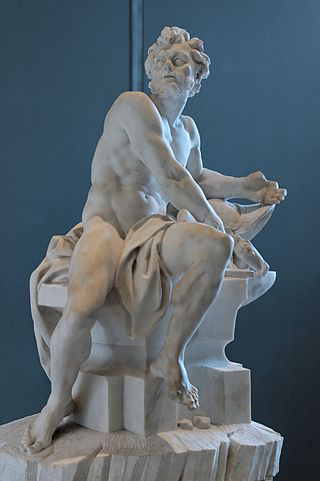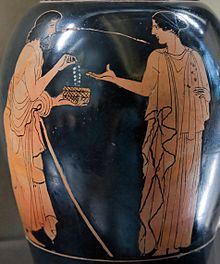
Ares is the Greek god of war and courage. He is one of the Twelve Olympians, and the son of Zeus and Hera. The Greeks were ambivalent towards him. He embodies the physical valor necessary for success in war but can also personify sheer brutality and bloodlust, in contrast to his sister Athena, whose martial functions include military strategy and generalship. An association with Ares endows places, objects, and other deities with a savage, dangerous, or militarized quality.

In ancient Greek religion, Hera is the goddess of marriage, women, and family, and the protector of women during childbirth. In Greek mythology, she is queen of the twelve Olympians and Mount Olympus, sister and wife of Zeus, and daughter of the Titans Cronus and Rhea. One of her defining characteristics in myth is her jealous and vengeful nature in dealing with any who offended her, especially Zeus's numerous adulterous lovers and illegitimate offspring.

Hephaestus is the Greek god of artisans, blacksmiths, carpenters, craftsmen, fire, metallurgy, metalworking, sculpture and volcanoes. Hephaestus's Roman counterpart is Vulcan. In Greek mythology, Hephaestus was either the son of Zeus and Hera or he was Hera's parthenogenous child. He was cast off Mount Olympus by his mother Hera because of his lameness, the result of a congenital impairment; or in another account, by Zeus for protecting Hera from his advances.

In Greek mythology, Cadmus was the legendary Greek hero and founder of Boeotian Thebes. He was, alongside Perseus and Bellerophon, the greatest hero and slayer of monsters before the days of Heracles. Commonly stated to be a prince of Phoenicia, the son of king Agenor and queen Telephassa of Tyre, the brother of Phoenix, Cilix and Europa, Cadmus traced his origins back to Poseidon and Libya.

In Greek mythology, Pentheus was a king of Thebes. His father was Echion, the wisest of the Spartoi. His mother was Agave, the daughter of Cadmus, the founder of Thebes, and grandson of the goddess Harmonia. His sister was Epeiros and his son was Menoeceus.

In Greek mythology, Agave, the daughter of Cadmus, was a princess of Thebes and the queen of the Maenads, followers of Dionysus.

In Greek mythology, Alcmaeon, as one of the Epigoni, was the leader of the Argives who attacked Thebes, taking the city in retaliation for the deaths of their fathers, the Seven against Thebes, who died while attempting the same thing.

In Greek mythology, Amphiaraus or Amphiaraos was the son of Oicles, a seer, and one of the leaders of the Seven against Thebes. Amphiaraus at first refused to go with Adrastus on this expedition against Thebes as he foresaw the death of everyone who joined the expedition. His wife, Eriphyle, eventually compelled him to go.

Eriphyle was a figure in Greek mythology who, in exchange for the necklace of Harmonia given to her by Polynices, persuaded her husband Amphiaraus to join the expedition of the Seven against Thebes. She was then slain by her son Alcmaeon. In Jean Racine's 1674 retelling of Iphigenia at Aulis, she is an orphan whose real name turns out to be Iphigenia as well; despite her many misdeeds, she rescues Iphigenia the daughter of Agamemnon.

In Greek mythology, Harmonia is the goddess of harmony and concord. Her Roman counterpart is Concordia. Her Greek opposite is Eris, whose Roman counterpart is Discordia.

In Greek mythology, King Laius or Laios of Thebes was a key personage in the Theban founding myth.

The Dionysiaca is an ancient Greek epic poem and the principal work of Nonnus. It is an epic in 48 books, the longest surviving poem from Greco-Roman antiquity at 20,426 lines, composed in Homeric dialect and dactylic hexameters, the main subject of which is the life of Dionysus, his expedition to India, and his triumphant return to the west.

The dynastic history of Thebes in Greek mythology is crowded with a bewildering number of kings between the city's new foundation and the Trojan War. This suggests several competing traditions, which mythographers were forced to reconcile.
In Greek mythology, Agenor was a Psophian prince.
In Greek mythology, Callirrhoe was the daughter of the river god Achelous. She was betrothed of Alcmaeon, son of Amphiaraus of Argos, and mothered by him two sons, Amphoterus and Acarnan.
In Greek mythology, Phegeus was the king of Psophis in Arcadia who purified Alcmaeon after the murder of his own mother, Eriphyle. The town of Phegeia, which had before been called Erymanthus, was believed to have derived its name from him. Subsequently, however, it was changed again into Psophis.
In Greek mythology, Temenus was the name attributed to the following personages:
In Greek mythology, Acarnan was son of Alcmaeon and Callirrhoe, and brother of Amphoterus.
In Greek mythology, Arsinoe, sometimes spelled Arsinoë,, was the name of the following individuals.
In Greek mythology, Amphilochus was an Argive hero and one of the Epigoni.













